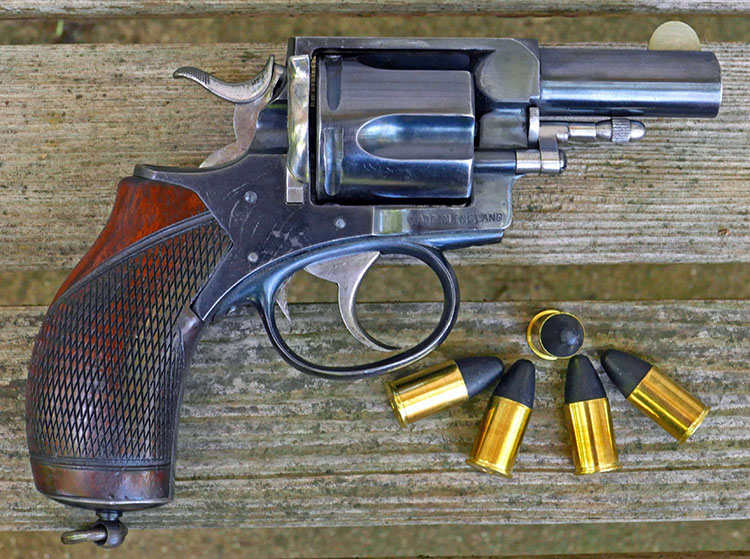|
A Webley RIC Pattern
Solid Frame Revolver
by Ed Buffaloe
I bought this gun because it is visually appealing to me and it can still be shot, as the British .455 cartridge remains in production. I have a weakness for large bore revolvers, particularly if they are
compact. However, far be it from me to attempt a history of Webley revolvers. Instead, I want to share this one revolver with the reader and explain what I have learned about it.
Apparently Webley was just another small-time weapon maker in the gun district of Birmingham until they got a contract to make 1000 pistols in .442 caliber for the Royal Irish Constabulary in
1868, based on a design they had first produced in 1867. These were the first RIC pattern revolvers, built on a short frame with a short cylinder, but with six shots and usually a longer
barrel than what is shown here, 4½” being typical. The RIC revolver eventually spawned the British Bulldog (1878-1912), the Metropolitan Police, the Army Express, and other Webley revolvers.
 |
I won’t bore the reader by explicating the permutations of RIC revolvers (which however can be discovered in the reference books listed below) but suffice it to say that eventually the RIC
revolver evolved into the gun pictured here, which is known as a Model 1883 or M/83. Black, Davis, & Michaud state: “The early RIC Model/83 was essentially the No. 2 British Bull Dog
with a truncated thickened grip. Unlike Webley’s British Bulldog, the later RIC Model/83s were made with a longer cylinder.”
The M/83 was kept in production longer than any other solid frame revolver. According to Black, Davis, and Michaud the company stopped ordering new frames from their supplier in 1893, but
they had so many left in inventory that the last guns were manufactured in the 1930’s, albeit in very small quantities. They were still being offered for sale new in the U.S. by the Stoeger company as late as 1928.
The M/83 is mostly found chambered in .450 or .455, but a few were made in .44 Russian, and the final production gun is chambered for the .45 ACP cartridge. They are all five-shot revolvers with
mostly short 2-3/8 to 2-1/2 inch barrels (though the very last gun produced was given a 3 inch barrel).
I wrote to Richard Milner at the Webley & Scott Archives and Research and paid £20 to learn that my gun was made in 1923 and sold to the W&C Scott Arms Company of New York in October of
1926. The highest known serial number for an M/83 is 102634, made sometime in the 1930’s, so my gun is only 204 guns from the end of production.
In the terminology of collectors, my M/83 would be described as follows: SN 102430, 2½” ovate barrel, high luster blue finish, large frame with broad stock, bronze front sight, elongated acorn
style ejector rod, conventional cylinder flutes, lanyard ring, with nitro proofs, marked ‘Webley Patents’ on the frame and ‘Webley & Scott Ltd Birmingham & London’ on the left side of the top
strap. Because it was to be retailed in the U.S. it is also marked ‘Made in England’ on the right side of the frame. I note that the vast majority of M/83 guns are marked ‘Webleys Patent RIC
Model/83 5 Shot’; why mine is marked differently I cannot say.
 |
Drawings by Ken Hallock from Webley Solid Frame Revolvers - used by permission of the authors.
|
 |
|
|
The double-action lockwork is based on William Tranter’s patent number 1913 of 1856 and licensed to Webley. The design features a sear that extends out of the frame into the area behind
the trigger. The back of the trigger engages the sear to release the hammer.
The one-piece grip is hollowed in the middle to accept the V-shaped mainspring. A smaller V-shaped spring tensions the trigger. The gun uses a swiveling ejector rod that is stored in the
hollow cylinder pin. A hand attached to the hammer rotates the cylinder in a clockwise direction. A lug on top of the hammer stops the cylinder by locking into one of five recesses set at the rear.
Fiocchi makes the most commonly found .455 ammunition, but I had trouble with the batch I bought.
One cartridge fired the primer but the powder did not ignite--I found the bullet on the ground about six feet short of the target. Recoil caused a bullet to work its way out of another Fiocchi cartridge,
locking up the cylinder. Fiocchi uses a cone-shaped 262 grain bullet. Another brand of ammunition, On-Target, loaded with a 262 grain round nose flat point bullet functioned flawlessly in the old gun, and I managed a
group about 2¼ inches across with it--single action of course. The double action trigger pull is a surprisingly good 12 pounds, but I would need an oversize grip to get the right distance to the trigger for my hands. Muzzle
velocity averaged a relatively slow 546 feet per second from the short barrel, giving a muzzle energy of 174 foot pounds, which is approximately equivalent to a .38 special target round. The swivel ejector rod is funky at
best, but works if you hold the cylinder in precisely the correct position. In its day the M/83 was an excellent revolver for close-in self-defense, and
could still be used today in a pinch. I have read that the Australians used some M/83 revolvers as late as World War II.
|